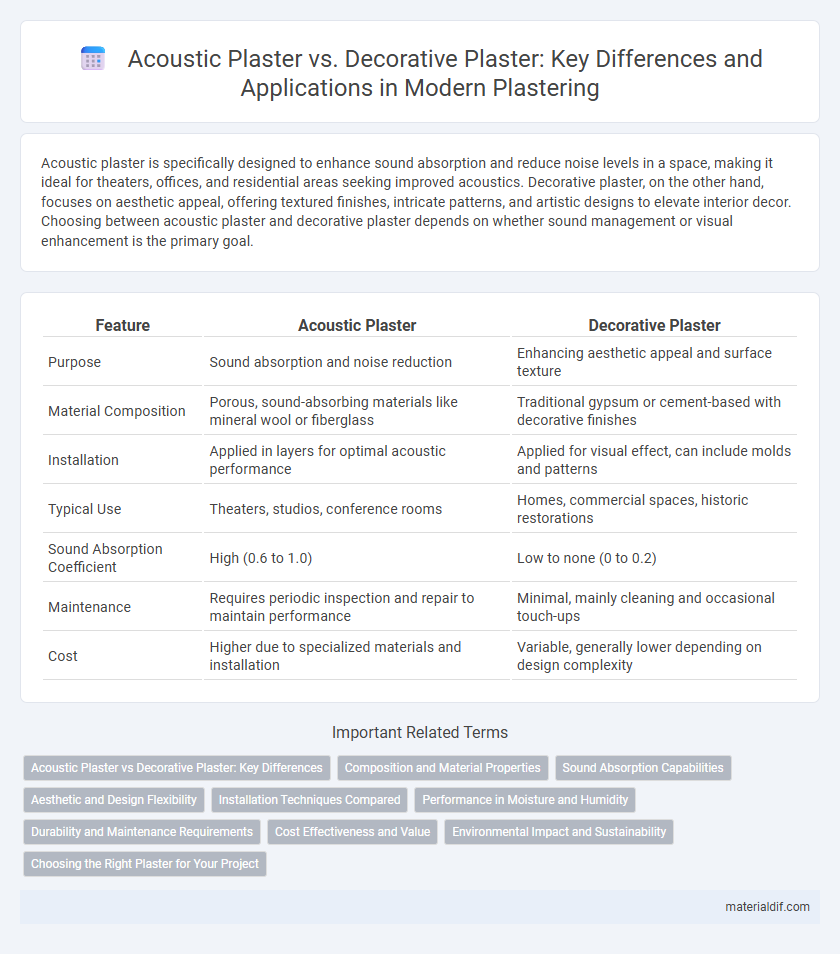Acoustic plaster is specifically designed to enhance sound absorption and reduce noise levels in a space, making it ideal for theaters, offices, and residential areas seeking improved acoustics. Decorative plaster, on the other hand, focuses on aesthetic appeal, offering textured finishes, intricate patterns, and artistic designs to elevate interior decor. Choosing between acoustic plaster and decorative plaster depends on whether sound management or visual enhancement is the primary goal.
Table of Comparison
| Feature | Acoustic Plaster | Decorative Plaster |
|---|---|---|
| Purpose | Sound absorption and noise reduction | Enhancing aesthetic appeal and surface texture |
| Material Composition | Porous, sound-absorbing materials like mineral wool or fiberglass | Traditional gypsum or cement-based with decorative finishes |
| Installation | Applied in layers for optimal acoustic performance | Applied for visual effect, can include molds and patterns |
| Typical Use | Theaters, studios, conference rooms | Homes, commercial spaces, historic restorations |
| Sound Absorption Coefficient | High (0.6 to 1.0) | Low to none (0 to 0.2) |
| Maintenance | Requires periodic inspection and repair to maintain performance | Minimal, mainly cleaning and occasional touch-ups |
| Cost | Higher due to specialized materials and installation | Variable, generally lower depending on design complexity |
Acoustic Plaster vs Decorative Plaster: Key Differences
Acoustic plaster is designed to absorb sound and improve room acoustics, featuring porous materials that reduce echo and noise levels. Decorative plaster primarily enhances aesthetic appeal with various textures and finishes but lacks significant sound absorption properties. Choosing between acoustic plaster and decorative plaster depends on whether sound control or visual style is the main priority in interior design.
Composition and Material Properties
Acoustic plaster is composed of sound-absorbing fibers and porous aggregates designed to enhance acoustic performance by reducing echo and reverberation in interior spaces. Decorative plaster typically contains lime, gypsum, or cement combined with pigments and additives to provide aesthetic finishes and texture without significant sound absorption properties. The material properties of acoustic plaster prioritize porosity and density control for optimal sound insulation, whereas decorative plaster emphasizes durability, adhesion, and visual appeal.
Sound Absorption Capabilities
Acoustic plaster is specifically formulated with sound-absorbing properties, utilizing materials such as mineral wool or fiberglass to reduce noise reverberation and improve room acoustics effectively. Decorative plaster primarily serves aesthetic purposes and lacks the porous structure necessary for significant sound absorption, making it less effective in controlling acoustic environments. Choosing acoustic plaster enhances sound quality by minimizing echo and background noise, while decorative plaster focuses on visual appeal without functional sound dampening.
Aesthetic and Design Flexibility
Acoustic plaster provides superior sound absorption while maintaining a smooth, seamless finish that integrates effortlessly into modern interiors. Decorative plaster offers a wide range of textures and intricate patterns, allowing for highly customized aesthetic designs to enhance architectural features. Choosing between acoustic and decorative plaster depends on prioritizing acoustic performance or creative visual expression in space design.
Installation Techniques Compared
Acoustic plaster installation involves applying a specialized, porous material directly onto surfaces to enhance sound absorption, requiring precise layering for optimal performance. In contrast, decorative plaster focuses on aesthetic finishes and can be applied using various techniques such as troweling or molding, often allowing for more intricate designs. Both methods demand skilled labor, but acoustic plaster installation prioritizes functional acoustic outcomes over purely visual appeal.
Performance in Moisture and Humidity
Acoustic plaster excels in moisture resistance by incorporating specialized materials that prevent mold growth and maintain sound absorption efficiency in humid environments. Decorative plaster often lacks these moisture-resistant properties, making it more susceptible to degradation and discoloration when exposed to high humidity. Choosing acoustic plaster ensures superior performance and durability in moisture-prone settings such as bathrooms and kitchens.
Durability and Maintenance Requirements
Acoustic plaster offers superior durability due to its specialized composition designed to absorb sound while resisting wear and tear, making it ideal for high-traffic areas. Decorative plaster, although visually appealing with intricate textures and finishes, often requires more frequent maintenance to prevent cracks and surface damage. Maintenance for acoustic plaster typically involves simple cleaning and occasional touch-ups, whereas decorative plaster demands careful upkeep to preserve its aesthetic qualities and structural integrity.
Cost Effectiveness and Value
Acoustic plaster offers superior cost effectiveness by combining sound absorption with a seamless finish, reducing the need for additional materials like panels or curtains. Decorative plaster, while enhancing aesthetic appeal, often involves higher labor and maintenance costs without providing acoustic benefits. Choosing acoustic plaster maximizes value by improving sound quality and durability in a single application.
Environmental Impact and Sustainability
Acoustic plaster is designed to improve sound absorption by incorporating eco-friendly materials like recycled fibers and low-VOC binders, enhancing indoor air quality and reducing environmental impact. Decorative plaster often relies on traditional mineral-based components that may have a higher carbon footprint due to mining and processing but can be long-lasting and recyclable. Choosing acoustic plaster can contribute to sustainable building practices by combining noise control with greener material compositions.
Choosing the Right Plaster for Your Project
Acoustic plaster enhances sound absorption and reduces noise levels, making it ideal for theaters, offices, and residential spaces requiring improved acoustics. Decorative plaster emphasizes aesthetic appeal with textured finishes and intricate designs, perfect for enhancing visual impact in historic restorations and upscale interiors. Selecting the right plaster depends on balancing acoustic performance needs with desired decorative effects to achieve both functional and aesthetic goals in your project.
Acoustic Plaster vs Decorative Plaster Infographic

 materialdif.com
materialdif.com